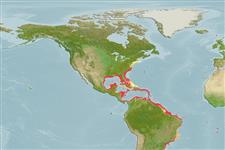>
Perciformes/Scorpaenoidei (Scorpionfishes) >
Scorpaenidae (Scorpionfishes or rockfishes) > Scorpaeninae
Etymology: Scorpaena: Latin, scorpaena = a kind of fish, 1706 (Ref. 45335).
Eponymy: Charles Plumier (1646–1704) was a Franciscan monk, botanist and naturalist. [...] (Ref. 128868), visit book page.
More on author: Bloch.
Environment: milieu / climate zone / depth range / distribution range
Ecologia
marinhas associadas(os) a recifes; intervalo de profundidade 1 - 70 m (Ref. 126840), usually 5 - 55 m (Ref. 5288). Subtropical; 43°N - 30°S, 98°W - 5°W
Western Atlantic: Bermuda, Massachusetts, and northern Gulf of Mexico to southern Brazil. Eastern Atlantic: Ascension and St. Helena.
Tamanho / Peso / Idade
Maturity: Lm ? range ? - ? cm
Max length : 45.0 cm TL macho/indeterminado; (Ref. 5288); common length : 30.0 cm TL macho/indeterminado; (Ref. 3812); peso máx. Publicado: 1.6 kg (Ref. 40637)
Espinhos dorsais (total) : 12; Raios dorsais moles (total) : 10; Espinhos anais: 3; Raios anais moles: 5. Occipital pit present; three to four spines on part of preorbital overlapping maxillary; large white spots on dark background on inner basal part of pectoral fin (unclear in specimens smaller than 3 cm SL) (Ref. 13608).
Found mostly in shallow coral reef and rocky areas. Lies motionless on the bottom (Ref. 9710). Feeds mostly on other fishes and crustaceans. Moderately common below about 5 m depth to at least 55 m. Displays characteristic bright white spots on dark background of pectoral axil when disturbed (Ref. 49392). Anterolateral glandular groove with venom gland (Ref. 57406). Eaten locally and said to taste a bit like chicken. Traded as an aquarium fish at Ceará, Brazil (Ref. 49392).
Life cycle and mating behavior
Maturidade | Reprodução | Desova | Ovos | Fecundidade | Larvas
Smith-Vaniz, W.F., B.B. Collette and B.E. Luckhurst, 1999. Fishes of Bermuda: history, zoogeography, annotated checklist, and identification keys. American Society of Ichthyologists and Herpetologists Special Publication No. 4. 424 p. (Ref. 35505)
Categoria na Lista Vermelha da IUCN (Ref. 130435: Version 2024-2)
Utilização humana
Pescarias: pouco comercial; Aquário: Espécies comerciais
Ferramentas
Relatórios especiais
Descarregue XML
Fontes da internet
Estimates based on models
Preferred temperature (Ref.
123201): 21.9 - 28, mean 25.6 °C (based on 770 cells).
Phylogenetic diversity index (Ref.
82804): PD
50 = 0.5000 [Uniqueness, from 0.5 = low to 2.0 = high].
Bayesian length-weight: a=0.01514 (0.00977 - 0.02344), b=2.99 (2.86 - 3.12), in cm total length, based on LWR estimates for this species & Genus-body shape (Ref.
93245).
Nível Trófico (Ref.
69278): 3.6 ±0.3 se; based on diet studies.
Resiliência (Ref.
120179): Baixo, tempo mínimo de duplicação da população 4,5 - 14 anos (Preliminary K or Fecundity.).
Fishing Vulnerability (Ref.
59153): Low to moderate vulnerability (35 of 100).
Nutrients (Ref.
124155): Calcium = 26.5 [10.7, 67.5] mg/100g; Iron = 0.53 [0.27, 1.47] mg/100g; Protein = 19.3 [17.6, 21.0] %; Omega3 = 0.293 [0.127, 0.806] g/100g; Selenium = 16.8 [7.9, 40.6] μg/100g; VitaminA = 58.3 [19.9, 179.9] μg/100g; Zinc = 0.815 [0.541, 1.238] mg/100g (wet weight);
